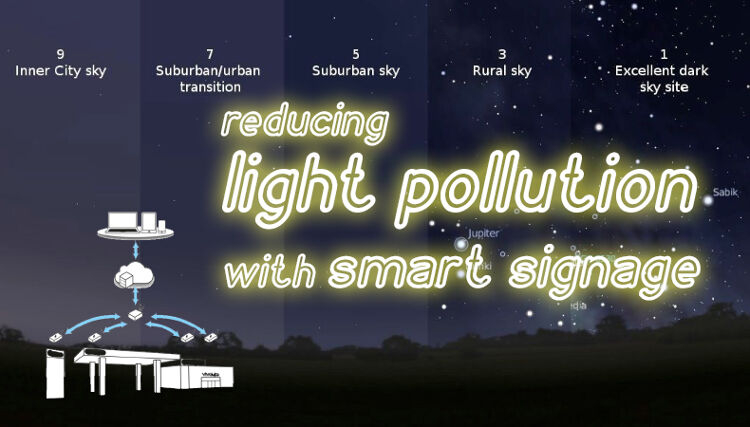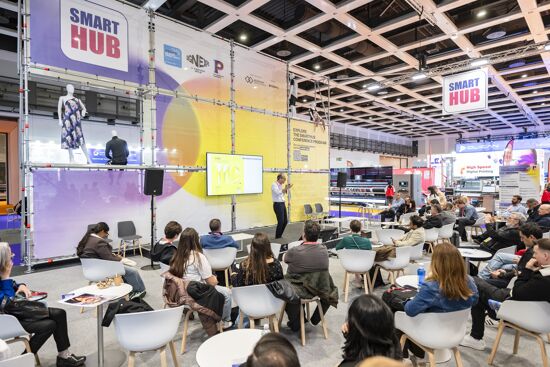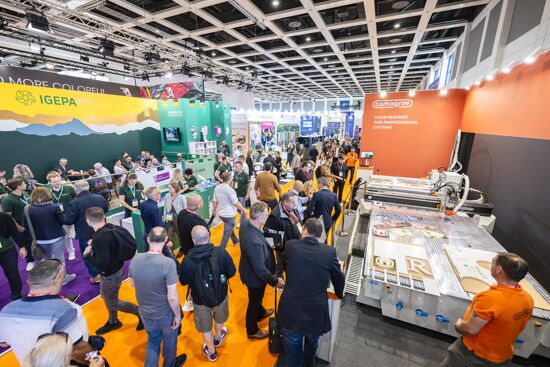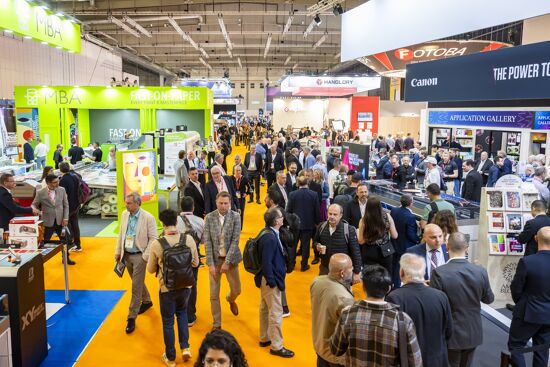Light pollution – a sensible approach for more sustainable signage

Light pollution can have a far-reaching influence on humans and wildlife alike, affecting our health and showing a serious impact on our climate. Artificial lights dispel the darkness of the night and bathe our cities in light. As such, they disrupt the natural balance of day and night, affecting the quality of our sleep.
Wasted light
Sources of light pollution include lighting in and outside of buildings, advertising, streetlights, and other illuminated spaces.
A remarkable fact is that a lot of this light is simply wasted. This is due to overly bright lights, improperly shielded lights, unnecessary illumination, and often a disinterested attitude towards the effects of light pollution.
What is light pollution?
The International Dark-Sky Association describes light pollution as “the inappropriate or excessive use of artificial light.” This includes glare, or excessive brightness; sky glow, which drowns out the night sky over urban areas; light trespass, or stray light falling where it is not needed; and clutter. A famous example of light pollution is the 1994 power outage in Los Angeles. Due to an earthquake, the city lost all electricity. Emergency centres started to get reports of a mysterious cloud above the city.
It turned out that there was no aliens invasion, but because of the darkness people could suddenly see the Milky Way again. Having been hidden by light pollution for decades, the sight was a remarkable experience for a lot of people.
Using artificial light sensibly
As humans, we don't want to live without artificial light again. And that is also not needed. but surely we can do something to avoid needless waste? What if we could keep the light but use it sensibly?
Why not reduce the use of LEDs that emit wavelengths affecting animals and humans and bounce around in the atmosphere needlessly? They can be replaced by LEDs with more favourable optical and electrical properties.
Simple interventions to fight light pollution
- Use lower colour temperature LEDs (light under 2200 Kelvin emits fewer blue wavelengths).
- Use dimmers, motion sensors, or timers on indoor and outdoor lighting to get the light under control.
- Use properly designed optical solutions in lighting fixtures that shield the light source and make sure that they illuminate only the intended area.
- Turn off unnecessary indoor lighting at night.
Using Smart Signage to reduce light pollution
Aided by a remote content management control system, a smart signage system allows you to change your content on any or all of your screens with a push of the button. No need to visit every digital sign to upload new content. Not only do you win a lot of time, but you also get access to some functions that can help fight light pollution.
Smart signage systems allow users to schedule content for particular times of the day. For example, a restaurant could use smart signage to show breakfast options in the morning, and lunch in the afternoon.
The scheduling function could ensure that messages are visible only when needed. So why not turn off the lightbox, or dim the lights when most people have gone to bed? It saves energy and money and it's an easy way to stop light pollution.
With smart signage solutions, it is possible to work in a very flexible way. Intelligent energy management makes the Smart Signage system an economic and ecological solution. It manages the light output of your LED installations based on pre-built scenarios and ambient conditions.
This smart use of energy does not only have great benefits for your company, but also for the environment. The total energy consumption can be lowered significantly, and the overall lifetime of the hardware is vastly prolonged. Less service and maintenance would be required, and even when needed, more effective planning could save tremendous costs and time.
With the impact of energy consumption, carbon footprint, ecological driven economy, as well as Covid, we all understand that the world has to become smarter. How can each of us in the signage and visual communication community pro-actively participate, contribute and combine our efforts, as responsible social citizens?
Vivalyte welcomes anyone interested, to participate in the dialogue with our team and move forward together. Curious how your region is scoring in light pollution? You can check this interactive world map of light pollution https://blue-marble.de/nightlights/2012 or this one:
https://cires.colorado.edu/artificial-sky
Visit Vivalyte at Stand 2-D39 at the European Sign Expo 2021 Europe’s dedicated signage and visual communications exhibition that serves the community as an unmissable platform to network, learn, gain access to experts and leaders in the market and, develop long term and profitable business connections. Register now and use promo code ESEH101 to receive a discount of 30 euros.
Topics
Interested in joining our community?
Enquire today about joining your local FESPA Association or FESPA Direct
Recent news

Industry Experts Explore the Evolution of Smart Manufacturing in the Textile Industry
A FESPA SmartHUB roundtable at Personalisation Experience 2025 discussed smart manufacturing's transformative impact on the textile industry. Experts highlighted the shift to on-demand customisation, driven by digital printing, data analytics, and automation. Key takeaways included enhanced machine control, significant waste reduction through intelligent software and colour management, and improved sustainability via energy efficiency and near-shoring, ensuring agility and environmental responsibility in textile production.

FESPA 2025 gathers leading visionaries from across the speciality print industry in Berlin
FESPA Global Print Expo 2025, European Sign Expo and Personalisation Experience (6 – 9 May 2025, Messe Berlin, Germany) welcomed Visionaries from across the speciality print industry to shape the future of print, develop forward-thinking business strategies, and explore innovative ways to translate emerging industry trends into tangible growth opportunities.

Exploring Cutting-Edge Textile Printing Innovation with Adobe Print Engine 7
Adobe PDF Print Engine 7, launched at FESPA Global Print 2025, significantly advances textile printing. Debbie McKeegan shares how it automates non-white substrate management and RGB colour handling, expands colour gamuts with in-RIP multicolour transparency blending, and streamlines workflows for efficiency and sustainability. This update boosts customisation, reduces waste, and positions businesses at the forefront of digital print innovation.

FESPA Global Print Expo 2025 - Overall Highlights
FESPA Global Print Expo, Europe's leading print and signage exhibition returned to Messe Berlin from 6 - 9 May 2025.